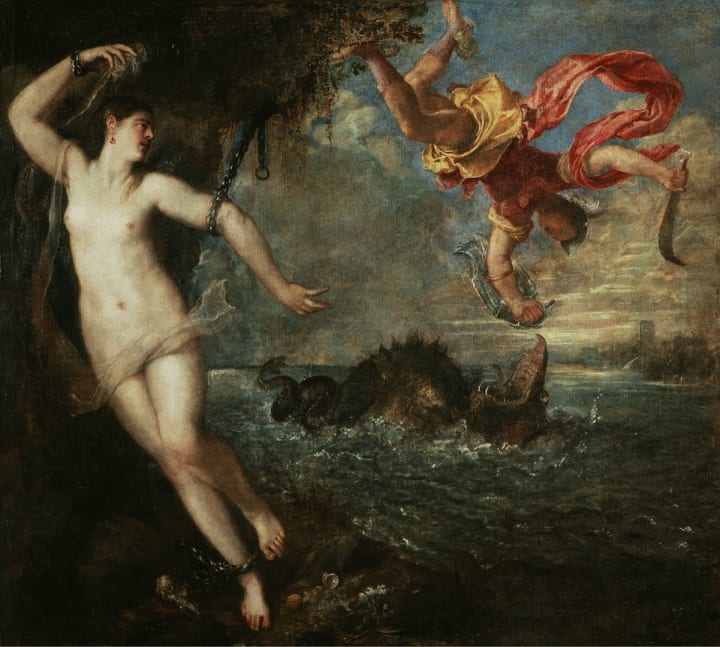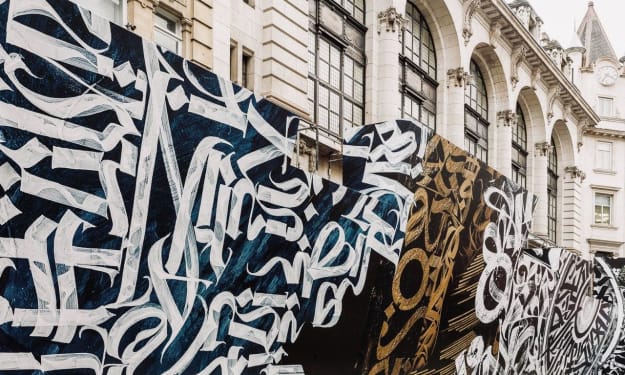Titian: Love, Desire, Death exhibition afterthoughts
Exploring questions of the choice of subject in Titian's cycle of mythological paintings

All the reviews of Titian’s exhibition at London's National Gallery that I have come across have been surprisingly different. As an art historian, I can appreciate the complexity with which those reviewers are approaching and unpacking the subject of the exhibition. However, none of them really focused their attention on an aspect that stroke me as a major focal point - Titian's choice of subjects - which happen to show the duality of beauty and power. So, I shall. Here, there will not be any “shocking” factual breakdowns of why using sex workers as models was meant to mock the patron of those works (Philip II - prince and then king of Spain that is), neither there will be any speculations on the cultural integration of slavery due to the colonialist expansion of Spain. As interesting as those things are, I would like to look at the visual and symbolic imagery of the mythological narratives that Titian chose, which are surprisingly topical.
A little bit of background first. The exhibition consists of 7 large scale paintings of Greco-Roman myths from Ovid's Metamorphoses, called poesie. They were commissioned, as mentioned earlier, by Philip II, prince and then king of Spain. Even though these paintings were never in one room together before due to Philip II's extensive travels, Titian intended for them to be viewed in the same space. Hence, the seemingly characteristic Titian's style further translated through the choice of story narratives. It is truly a treat for an art nerd to see them all together in the same space - as it was intended by the Master 500 years ago.
Titian had 15 books, over 250 myths to choose from - he made some very careful, thought out choices, which bound the narrative of the cycle not only by the fact that the subjects are all mythological - but by a deeper, more intrinsic value of power and beauty (which also had women as their main subjects of the narrative). As I was walking through the room of those paintings I could not help but feel the dissonance between the representation of the subject and the subjects themselves. More often than not, I was feeling sorry for the women in those paintings - Danaë, Venus, Europa, Andromeda - who are so beautiful, yet always seem to face a struggle. The narrative of gods taking advantage of the goddesses as we know them is way too familiar in the Old Masters' art world - and you do not hear those stories in primary school when you learn about greek mythology - that would not have been a PG lesson...

Take, for example, the first painting in the cycle - Danaë. The perfect Titian female nude, which resembles a couple of his other paintings, with a seemingly unbothered Danaë being showered in gold by Jupiter (Zeus) who happens to materialise in such form from the sky. Nothing unusual from a first glance, until you find out that she got pregnant with Jupiter's child afterwards, making a story (and the underlying meaning of the painting) not so PG after all. It has been noted, that Titan often represented women along such illicit narratives and he was not shy of overly indicating the level of excitement that those females are experiencing. Here, the discontent with which Danaë is just accepting the situation she finds herself in is highly evident, making for an interesting first painting in this poesie cycle.

Another woman suffering in this room is Venus (Aphrodite), in Venus and Adonis. The goddess of love and beauty who is meant to embody all the positives of life is shown in an attempt to stop her lover, Adonis, from facing his fate - death while hunting. She is unsuccessful. He does not return from his trip, leaving Venus devastated. The disparity from the conventional representation of Venus is dramatic here as she is turned with her back to the viewer, where the only aspect that one can 'judge her beauty' on is her hair and 1/3 of her face - unlike the usual full frontal views. Here, our attention is drawn to her not as a goddess of beauty, but as one of the suffering women, who also experience the pain of loss. Even the goddess of love loses her lover in an unstoppable and inevitable process - says Titian (quoting Ovid) - so we should let it happen if it is meant to. The subject can be read as a sensual and somewhat selfish desire for love, however, the tenderness with which Venus looks at Adonis and the rays of light which represent her exploding emotions as he is killed would call to differ.

Perhaps the only semi-positive story in that cycle is of Perseus and Andromeda. Although the painting seemingly differs in style from the rest of the series (it is much darker and somewhat unsettling due to the central figure of the monster), it is in keeping with Titian's conventions. The idealised female nude occupies 1/3 of the picture plane, contrasted with a splash of bright colour for Persius' clothing as he dramatically leaps to fight the monster. He saves Andromeda from the sea creature and they marry - as he fell in love with her instantly when he saw her (the myth does not specify if she does too). Comparing with the preceding discussion, this seems like the only positive story in the room, ironically illustrated in the gloomiest way possible. I am sure, Andromeda would much rather marry Persius than being eaten by a sea monster, but, once again, the helplessness of the woman's situation in this story and the painting is disquieting.

To end on the most well-known story which is unapologetically disturbing - Rape of Europa also known as Abduction of Europa. The painting is, perhaps, the most beautiful one in the room (at least in my humble opinion). Striking blue skies, the angels with their small colourful wings, beautiful drapery and the realistic bull almost make me forget the narrative of the myth. But not quite. Jupiter (Zeus), a recurring character of the nonconsensual sexual encounters in those myths, makes it into yet another poesie. Disguised as a buff, he steals Europa off of her native island and brings her to Crete, where he makes her his lover. Another not-so-PG problematic myth which definitely does not go unnoticed. The feelings of appreciation for great art fight with my inner feminist over whether this is one of Titian's greatest paintings. The drama and beauty are conveyed on a grand scale, the colour balance is perfect and the small details such as the fish creatures, angels' wings, bull's flower crown and the distress on the hardly visible face of Europa - all create an oeuvre of aesthetic thrill which is hard to resist. I will continue contemplating on the duality of feelings this painting creates for another couple of days. I will leave the final judgment of this painting up to my reader.
Honestly, this is not the direction of thought I expected this exhibition to take me in. I was going in, expecting romantic scenes of joys of life, easy subjects and maybe some sensual undertones. But to see the variety of complex narratives, told through Titian's brush left me puzzled over the meaning of his choices. Maybe I am reading too much into it (which is sometimes the case with art historians, unsurprisingly), but on the other hand, the fun of questioning those aspects of the works is that you may never actually know the answer, so, we may all just have to come up with one to satisfy ourselves.
Thank you for reading this story! If you enjoyed it, please share and tip if you can. Stay tuned for more art writing! If you want to discuss anything mentioned above, do reach out on Twitter - I'll be happy to talk more art!







Comments
There are no comments for this story
Be the first to respond and start the conversation.